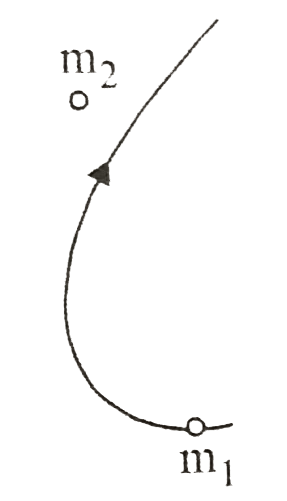Figure shows the initial position of a system of two particles. Given that centre of mass of the system remains at rest particle A moves i a trajectory givenn by x2a2+y2b2=1
Pick the correct option (s) for the nature of B's trajectory and the coordinates of B at the instant when A was at the position (0,b).

Trajectory of B is elliptical
Trajectory of B is circular
(0,−b2)
(a2,−b2)
The correct Answer is:A, D
2mxB+mxA3m=a3⇒xA=a−2xB
2myB+myA3m=0⇒yA=2yB
Trajectory of B is (a−2x)2a2+(2y)2b2=1
Topper's Solved these Questions
- TEST PAPERSBOOK - FIITJEECHAPTER - TEST PAPERSEXERCISE - PHYSICS
747 Videos
- SIMPLE HARMONIC MOTIONBOOK - FIITJEECHAPTER - SIMPLE HARMONIC MOTIONEXERCISE - Assignment Problems (Objective) (Level-II)
20 Videos
- WORK, ENERGY AND POWER BOOK - FIITJEECHAPTER - WORK, ENERGY AND POWER EXERCISE - COMPREHENSIONS ( Comprehension-II)
5 Videos
Similar Questions
The coordinates of the centre of mass of a system of three particles of mass 1g,2g and 3g are (2,2,2). Where should a fourth particle of mass 4 g be positioned so that the centre of mass of the four particle system is at the origin of the three-dimensional coordinate system ?
View SolutionThe coordinates of the centre of mass of a system of three particles of mass 1g,2g and 3g are (2,2,2). Where should a fourth particle of mass 4 g be positioned so that the centre of mass of the four particle system is at the origin of the three-dimensional coordinate system ?
View Solution
Knowledge Check
If →RCM is the position of the centre of mass of a system of two particles of masses m1 and m2 then →RCM is given by :
Am1+m2m1→r1+m2→r2Bm1m2m1→r1+m2→r2Cm1→r1+m2→r2m1+m2Dm1→r1+m2→r2m1m2The coordinate of a moving particle at any instant of time t are x = at and y=bt2. The trajectory of the particle is
Ay=b2xa2By=b2x2a2Cy2=b2a2Dy=bx2a2The potential energy U(in J) of a particle is given by (ax+by), where a and b are constants. The mass of the particle is 1kg and x and y are the coordinates of the particle in metre. The particle is at rest at (4a,2b) at time t=0.
Find the coordinates of the particle at t=1 second.A(3.5a,1.5b)B(3a,2b)C(3a,3b)D(3a,4b)
The coordinate of a moving particle at any instant of time t are x = at and y=bt2. The trajectory of the particle is
View SolutionPath traced by a moving particle in space is called trajectory of the particle. Shape of trajectiry is decided by the forces acting on the particle. When a coordinate system is associated with a particle motion, the curve equation in which the particle moves [y=f(x)] is called equation of trajectory. It is just giving us the relation among x and y coordinates of the particle i.e. the locus of particle. To find equation of trajectory of a particle, find first x and y coordinates of the particle as a function of time eliminate the time factor.
The position vector of car w.r.t. its starting point is given as →r=atˆi−bt2ˆj where a and b are positive constants. The locus of a particle is:-
View SolutionStatement-1 : The centre of mass of a system of n particles is the weighted average of the position vector of the n particles making up the system
. Statement-2 : The position of the centre of mass of a system is independent of coordinate system
View SolutionTwo interacting particles form a closed system whose centre of mass is at rest. Fig. illustrates the positions of both particles at a certain moment and the trajectory of the particle of mass m1. Select the trajectory of the particle of mass m2 if m2=m1.

View SolutionPath traced by a moving particle in space is called trajectory of the particle. Shape of trajectiry is decided by the forces acting on the particle. When a coordinate system is associated with a particle motion, the curve equation in which the particle moves [y=f(x)] is called equation of trajectory. It is just giving us the relation among x and y coordinates of the particle i.e. the locus of particle. To find equation of trajectory of a particle, find first x and y coordinates of the particle as a function of time eliminate the time factor.
The position vector of car w.r.t. its starting point is given as →r=atˆi−bt2ˆj where a and b are positive constants. The locus of a particle is:-
View Solution
